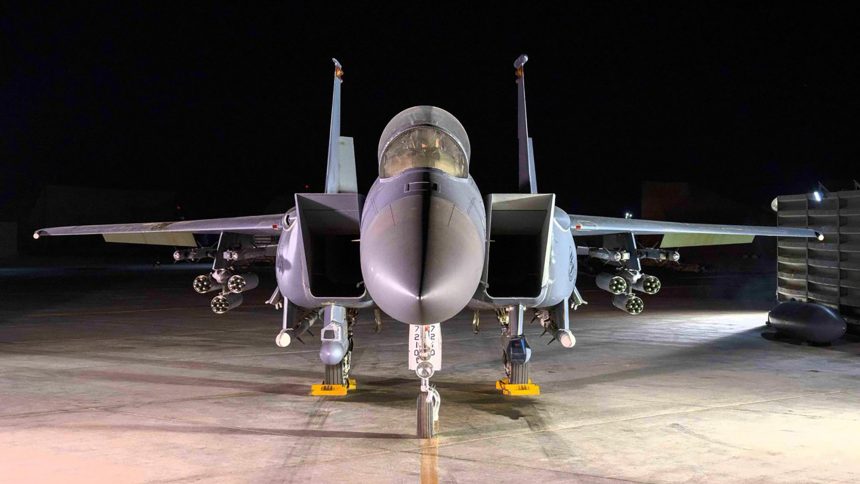A few days after the first images emerged of Strike Eagles carrying four or six LAU-131 pods for drone-hunting missions, U.S. CENTCOM has released a photograph showing the same loadout on an operationally deployed F-15E.
The new anti-UAV loadout made of six LAU-131A rocket launchers that we observed on F-15Es involved in tests at Eglin Air Force Base recently have made it to the CENTCOM AOR (Area Of Responsibility).
The U.S. Command has just shared an image showing one of the F-15Es deployed to the Middle East carrying six LAU-131 pods for a total of 42 AGR-20 APKWS II (Advanced Precision Kill Weapon System II) laser guided rockets. In fact, the LAU-131A/A, an extended version of the standard LAU-131A, can carry 7 rockets.
U.S. Air Force F-15E Strike Eagle in the U.S. Central Command area of responsibility. pic.twitter.com/xxg6F6LlqB
— U.S. Central Command (@CENTCOM) May 30, 2025
Interestingly, along with the 42 rockets, the F-15E appears to be loaded with 4x AIM-9X and 4x AIM-120C/D AAMs (Air-to-Air Missiles).
Although the original post did not disclose where the F-15E is stationed, it took only a few minutes for OSINT Researcher Evergreen Intel to geolocate the image and also gather additional details about the aircraft.
*took 3 minutes.
— Evergreen Intel (@vcdgf555) May 30, 2025
As already explained in detail in our recent article on the F-15Es’ APKWS rocket testing at Eglin AFB, the same type of weapon has recently been introduced in the air-to-air role by the U.S. Air Force’s F-16s engaged in drone intercept missions around the Red Sea.
Originally designed as a low-cost, laser-guided precision munition for air-to-ground targets, APKWS II was first tested for air-to-air use in 2019. It offers an affordable option for engaging slow-moving aerial threats such as drones and cruise missiles. During recent operations, F-16s have typically worked in pairs: one aircraft designated the target using the Sniper Advanced Targeting Pod, while the other executed the attack run with the rockets.
Compared to traditional air-to-air missile loadouts, the APKWS configuration allowed the F-16 to increase its engagement capacity significantly. While a standard load of AIM-9X and AIM-120 missiles offers six shots, carrying one or two rocket pods with APKWS enabled the Viper to triple that number. This was achieved at a fraction of the cost as each APKWS rocket is estimated at around 30,000 USD, while an AIM-9X costs approximately 450,000 USD and an AIM-120 exceeds 1 million USD per unit. The tradeoff, however, is that APKWS rockets are only effective against predictable targets with limited maneuverability.
The loadout recently tested on the F-15E takes the concept even further. With six LAU-131 pods installed, the Strike Eagle can carry up to 42 APKWS rockets in addition to its standard complement of eight air-to-air missiles. This gives the aircraft up to 50 engagement opportunities before even accounting for the internal gun. The layout also provides greater operational flexibility: the Weapons Systems Officer in the back seat can laser-designate targets using the Sniper ATP while the pilot concentrates on the engagement, eliminating the need for paired operations like those conducted with the F-16.
The integration of APKWS II on the Strike Eagle appears to be a logical evolution. During the April 2024 Iranian drone attack against Israel, F-15Es were among the aircraft tasked with intercepting the wave of incoming drones. One of the limiting factors during that operation was the limited number of air-to-air missiles available to each jet. An F-15E outfitted with a high-capacity rocket loadout would significantly extend the duration and effectiveness of counter-UAS sorties.
APKWS II has already been fielded across several U.S. platforms, including the USMC’s AV-8B Harrier and F/A-18C/D Hornets, AH-1Z Vipers and UH-1Y Venoms, the USAF’s A-10Cs and F-16s, the U.S. Navy’s MH-60R/S helicopters, and the U.S. Army’s AH-64D/E Apaches.
The APKWS II is based on the Hydra 70 unguided rocket and incorporates a laser guidance kit between the warhead and the rocket motor. This low-cost modification transforms a simple unguided munition into a precision weapon. The system uses four pop-out wings with laser-seeker optics, known as the Distributed Aperture Semi-Active Laser Seeker (DASALS), which provide wide field-of-view tracking for both stationary and moving targets.
To further enhance its counter-UAS capabilities, the APKWS underwent an upgrade under the Fixed Wing, Air Launched, Counter-Unmanned Aircraft Systems Ordnance (FALCO) program. The AGR-20 FALCO version includes updated software that improves its performance in air-to-air roles. This variant is already in use within the CENTCOM area of responsibility and has demonstrated a high probability of kill in operational scenarios.
In addition, BAE Systems has revealed a new infrared seeker for the APKWS II, complementing the laser guidance and making the rocket a dual-mode weapon. This enhancement builds upon the FALCO upgrade and is expected to further improve the Air Force’s ability to counter a wide range of aerial threats.
The addition of APKWS II to the F-15E’s arsenal reflects an ongoing effort to enhance capacity and reduce the cost of countering drones in contested airspace.









